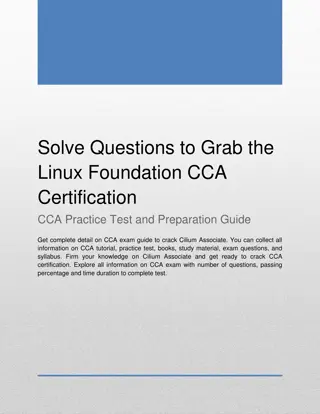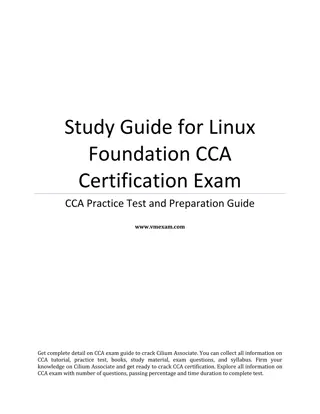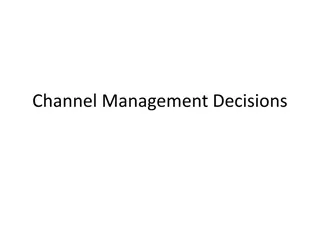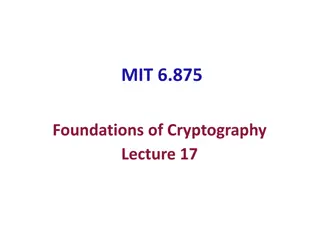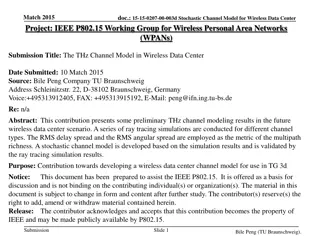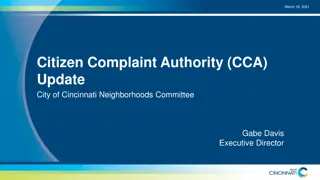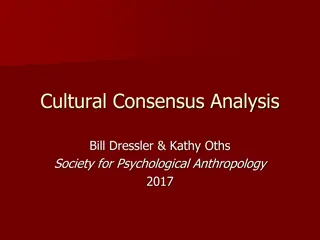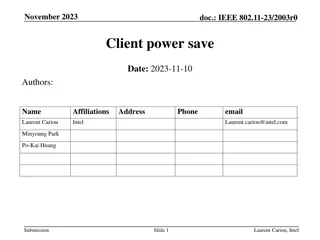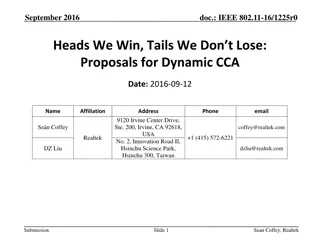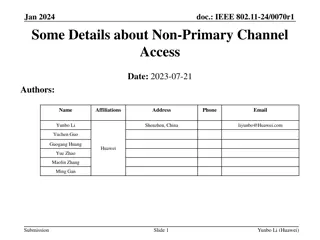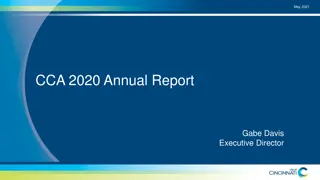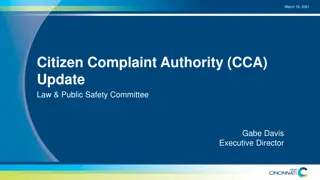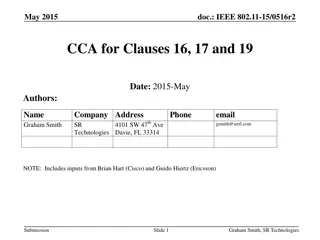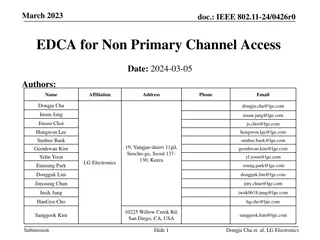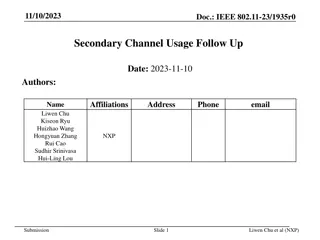Clear Channel Assessment (CCA) Behavior of Commercial Wi-Fi Equipment
This document, dated July 2022, delves into the Clear Channel Assessment (CCA) behavior of commercial Wi-Fi equipment in response to Narrowband Frequency Hopping (NB FH) signals. It explores the regulatory framework around license-exempt frequency bands in the USA and Europe, highlighting the specifics of operation in the 6 GHz spectrum. The study includes an analysis of how Wi-Fi products react to NB FH signals present in the same frequency channel, along with the emulation of future NB FH radio signals in the Wi-Fi environment.
Download Presentation

Please find below an Image/Link to download the presentation.
The content on the website is provided AS IS for your information and personal use only. It may not be sold, licensed, or shared on other websites without obtaining consent from the author. Download presentation by click this link. If you encounter any issues during the download, it is possible that the publisher has removed the file from their server.
E N D
Presentation Transcript
July 2022 doc.: IEEE 802.11-22/998r0 Clear Channel Assessment (CCA) behavior of commercial Wi-Fi equipment Date: 2022-07-14 Authors: Name Jeff Bailey Affiliations Carleton University Address Phone email jeffbailey@cmail.carleton.ca ioannis@sce.carleton.ca John Lambadaris Carleton University Roger Selzer Carleton University stoneliu@cmail.carleton.ca sebastian.max@ericsson.com david.sugirtharaj@ericsson.com Stone Liu Carleton University Sebastian Max Ericsson David Sugirtharaj Ericsson Submission Slide 1 Jeff Bailey, Carleton University
July 2022 doc.: IEEE 802.11-22/998r0 Abstract (1) In 2020, Federal Communications Commission (FCC) made available 5.925 GHz to 7.125 GHz for license-exempt use in the USA [1] In 2020, Electronic Communications Committee (ECC) permitted European countries to make available 5.945 GHz to 6.425 GHz for license- exempt use [2] In 2021, the European Commission (EC) mandated all European Union (EU) member states to implement the decision [3] Submission Slide 2 Jeff Bailey, Carleton University
July 2022 doc.: IEEE 802.11-22/998r0 Abstract (2) The ECC and subsequent EC decisions explicitly permit Narrowband Frequency Hopping (NB FH) as one mode of operation in 6 GHz Known as EN 303 687 [4], the European Telecommunication Standards Institute (ETSI) [5] Technical Committee (TC) Broadband Radio Access Networks (BRAN) [6] develops a Harmonised Standard (HS) that specifies requirements for operation in 6 GHz HSs enable manufacturers to put products on the EU market without type approval The conditions for consideration of NB FH in EN 303 687 are under discussion In this presentation, we analyze how commercial Wi-Fi products react to NB FH signals present in the same frequency channel Submission Slide 3 Jeff Bailey, Carleton University
July 2022 doc.: IEEE 802.11-22/998r0 Frequency Hopping Traffic Emulation of future NB FH radio signals A 2 MHz band limited additive gaussian noise (BLAGN) signal is produced in baseband BLAGN signal transmitted into Wi-Fi channel at different offsets from the Wi-Fi channel center frequency Transmitted as pulses with varying dwell times and duty cycles, emulating hopping in and out of the specified Wi-Fi channel Submission Slide 4 Jeff Bailey, Carleton University
July 2022 doc.: IEEE 802.11-22/998r0 NB FH Signals in Time Domain 20 % Duty Cycle, 60 ms dwell time NB FH Signal Dwell Time Duration that signal is active T Periodicity of the signal Duty Cycle Ratio of dwell time to period Normalized absolute magnitude Dwell Time T Time (s) Submission Slide 5 Jeff Bailey, Carleton University
July 2022 doc.: IEEE 802.11-22/998r0 PSD of NB FH and Demodulated Wi-Fi link PSD of NB FH & Wi-Fi Channel Power Spectral Density (PSD) of NB FH transmission shown in red PSD of demodulated Wi-Fi transmission (captured by software defined radio) shown in blue Normalized Power/Frequency Frequency (Hz) Submission Slide 6 Jeff Bailey, Carleton University
July 2022 doc.: IEEE 802.11-22/998r0 Test setup Monitor UDP traffic (iperf) from source to sink over Wi-Fi link Measured throughput averaged over 60 s Measuring impact on throughput As percentage of throughput of un- interfered Wi-Fi link (nominal throughput) NB FH signal strength is 6 dB lower than Wi-Fi Wi-Fi signal strength at receiving station: 52 dBm NB FH signal strength at receiving station: 58 dBm Various combinations of NB FH duty cycle, dwell time, and frequency offset Automated testing of 245 combinations Submission Slide 7 Jeff Bailey, Carleton University
July 2022 doc.: IEEE 802.11-22/998r0 Test Setup (Diagram) Ethernet cable Co-axial cable Co-axial power splitter Emulating Competing Traffic AP #1 AP #2 Attenuator Attenuator PC: Traffic sink (iperf server, UDP) PC: Traffic source (iperf client, UDP) USRP B210 [7] #1: Configured to transmit NB FH signals USRP B210 #2: Configured to observe the channel RF-Isolation Chamber Submission Slide 8 Jeff Bailey, Carleton University
July 2022 doc.: IEEE 802.11-22/998r0 2 MHz NB FH Signals Impact on Wi-Fi Throughput Submission Slide 9 Jeff Bailey, Carleton University
July 2022 doc.: IEEE 802.11-22/998r0 Detailed Analysis of Impact on Wi-Fi Throughput Results show consistently: Higher duty cycle and less dwell time has the highest impact on the Wi-Fi channel Throughput Dwell time Worst case throughput less than 20 % of maximum Wi-Fi throughput Very little impact on Wi-Fi throughput at longer dwell times for each duty cycle tested Across all scenarios, short dwell time has largest impact on Wi-Fi throughput Increased duty cycle results in decreased throughput Submission Slide 10 Jeff Bailey, Carleton University
July 2022 doc.: IEEE 802.11-22/998r0 Impact of NB FH Signals on other commercial Wi-Fi Devices Experiments repeated with Linksys device Same 245 test cases as in previous setup Linksys device used as traffic sink Linksys WRT3200ACM Submission Slide 11 Jeff Bailey, Carleton University
July 2022 doc.: IEEE 802.11-22/998r0 2 MHz NB FH Signals Impact on Wi-Fi Throughput (Linksys device as receiver) Submission Slide 12 Jeff Bailey, Carleton University
July 2022 doc.: IEEE 802.11-22/998r0 Impact of Dwell Time on Wi-Fi throughput Time Case 1: Submission Slide 13 Jeff Bailey, Carleton University
July 2022 doc.: IEEE 802.11-22/998r0 Impact of Dwell Time on Wi-Fi throughput Time Case 1: Submission Slide 14 Jeff Bailey, Carleton University
July 2022 doc.: IEEE 802.11-22/998r0 Reason for Wi-Fi performance impact? Wi-Fi fails to detect NB FH signals via CCA Wi-Fi datagrams are transmitted over NB FH transmissions, thus resulting in reception errors Wi-Fi detects NB FH signals via CCA Wi-Fi will back-off and delay its transmission, thus reducing throughput Submission Slide 15 Jeff Bailey, Carleton University
July 2022 doc.: IEEE 802.11-22/998r0 Assumption: Wi-Fi has issues consistently detecting all NB FH transmissions Two additional measurements conducted 1. Observation of radio channel Identify concurrent transmissions (Wi-Fi and NB FH) 2. Modify Wi-Fi product s firmware to output CCA internal states Busy and idle states Submission Slide 16 Jeff Bailey, Carleton University
doc.: IEEE 802.11-22/998r0 1. Observing the Channel PSD during NB FH transmission Recording of Wi-Fi and NB FH transmissions Normalized Power/Frequency Normalized Amplitude of recorded Signal NB-FH Transmission Time (s) Frequency (Hz) Submission Slide 17 Jeff Bailey, Carleton University
July 2022 doc.: IEEE 802.11-22/998r0 2. Observing CCA Mechanism s Internal States RF-Isolation Chamber Modified access point Capable of logging the internal state of CCA mechanism Records duration that AP deems channel to be occupied No Wi-Fi traffic (generation of beacons and all other management traffic disabled) Pure passive monitoring Compare Known transmission duration with Channel occupation duration as determined by Wi-Fi CCA mechanism Modified AP Attenuator USRP B210 configured to transmit NB FH signals Submission Slide 18 Jeff Bailey, Carleton University
July 2022 doc.: IEEE 802.11-22/998r0 Detectability of NB FH Transmissions NB FH signal setup Signal strength of 45 dBm at Wi-Fi receiver 20 % duty cycle Varying dwell times CCA mechanism fails to reliably detect NB FH signals transmitted at longer dwell times Dwell Time Detection ratio 100 s 54.05 % 500 s 13 % 1000 s 6.65 % 2000 s 3.4 % 4000 s 1.7 % 16 000 s 0.44 % 60 000 s 0.125 % Submission Slide 19 Jeff Bailey, Carleton University
July 2022 doc.: IEEE 802.11-22/998r0 Summary Dwell time of NB FH signals impacts Wi-Fi throughput Wi-Fi CCA mechanism is unable to reliably detect NB FH signals Results are consistent across many portions of the Wi-Fi channel Offset from centre frequency has no observable impact Results are consistent across multiple Wi-Fi devices Although Linksys device is less affected than Ericsson device Submission Slide 20 Jeff Bailey, Carleton University
July 2022 doc.: IEEE 802.11-22/998r0 DEMO One moment please Submission Slide 21 Jeff Bailey, Carleton University
July 2022 doc.: IEEE 802.11-22/998r0 References 1. Federal Communications Commission, FCC adopts new rules for the 6 GHz band, unleashing 1,200 Megahertz of spectrum for unlicensed use, Apr. 23, 2020. [Online]. Available: https://docs.fcc.gov/public/attachments/DOC- 363945A1.pdf Electronic Communications Committee, On the harmonised use of the frequency band 5945-6425 MHz for Wireless Access Systems including Radio Local Area Networks (WAS/RLAN), ECC Decision (20)01, Nov. 20, 2020. [Online]. Available: https://docdb.cept.org/download/1448 European Commission, On the harmonised use of radio spectrum in the 5 945-6 425 MHz frequency band for the implementation of Wireless Access Systems including Radio Local Area Networks (WAS/RLANs), Commission implementing decision (EU) 2021/1067, Jun. 17, 2021. [Online]. Available: https://eur-lex.europa.eu/legal- content/EN/TXT/PDF/?uri=CELEX:32021D1067 ETSI, 6 GHz WAS/RLAN; Harmonised Standard for access to radio spectrum, Draft ETSI EN 303 687, Apr. 2022. [Online]. Available: https://www.etsi.org/deliver/etsi_en/303600_303699/303687/01.00.00_20/en_303687v010000a.pdf European Telecommunication Standards Institute (ETSI), About ETSI, accessed Jul. 2022. [Online]. Available: https://www.etsi.org/about ETSI Technical Committee (TC) Broadband Radio Access Networks (BRAN), BRAN Summary, accessed Jul. 2022. [Online]. Available: https://portal.etsi.org/TB-SiteMap/BRAN/Summary Ettus Research, Universal Software Radio Peripheral Board 210, accessed Jul. 2022. [Online]. Available: https://www.ettus.com/all-products/ub210-kit/ 2. 3. 4. 5. 6. 7. Submission Slide 22 Jeff Bailey, Carleton University





